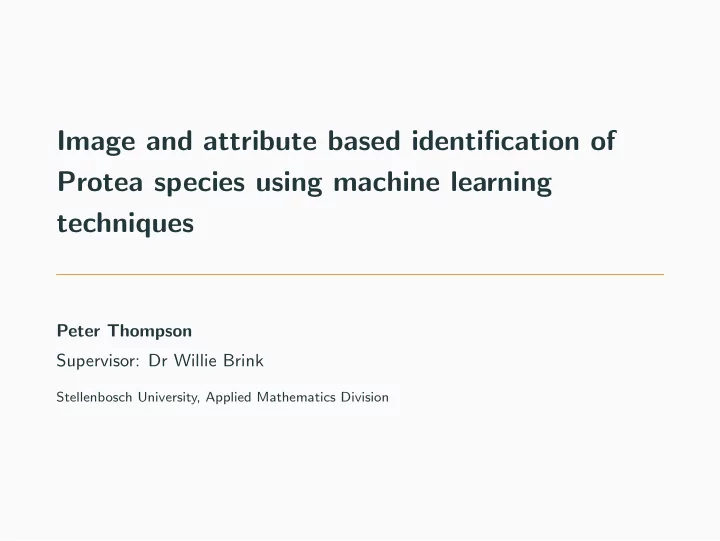

Image and attribute based identification of Protea species using machine learning techniques Peter Thompson Supervisor: Dr Willie Brink Stellenbosch University, Applied Mathematics Division
Introduction South Africa is very rich in plant species with roughly 24,000 taxa, of which 80% are endemic. • Cape Floristic Region (mainly fynbos) contains 9,000 of 24,000 taxa in a 6% area • Genus Protea is archetype of fynbos • 80 Protea species in fynbos • How to identify them? Figure 1: Protea magnifica 1
Data Protea Atlas Project (PAP) iNaturalist • Ran for 10 years and headed • Natural continuation of PAP by Dr Tony Rebelo • Amateur botanists upload • 150,000 species records at pictures of species, with added 62,000 localities metadata, i.e. location, flowering etc. • Includes location, elevation, flowering times, numbers etc. Figure 2: iNaturalist observation of Protea nana 2
Distribution of Protea cynaroides in the Western Cape 3
Problem Statement flowering elevation Species location height 4
Current Approach P (protea i | loc , ele , image , . . . ) Current setup Difficulties • Naive Bayes • Small dataset with large tail • 20% accuracy which jumps to • 3,500 observations with 2,400 80% when considering top-5 flower head photos • Two CNNs built on Inception • 50% of data in 7 species • First CNN classifies 8 most • Intraspecies variation often observed species (72% larger than interspecies accuracy) variation • Second CNN looks at the rest • Large dataset bias for common species 5
Future Work Ideas • Incorporate visual aspect • Consider dependencies between attributes • Incorporate more attributes • Generative approach to image classification (e.g. VAEs), linking with the attributes in a PGM Figure 3: Protea rupicola high up on the Kammanassie 6
Recommend
More recommend